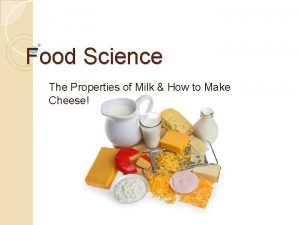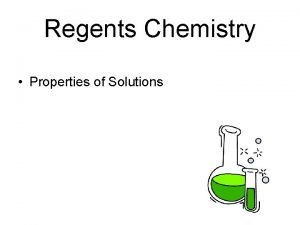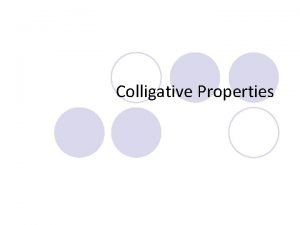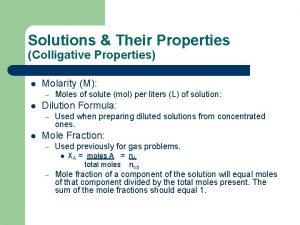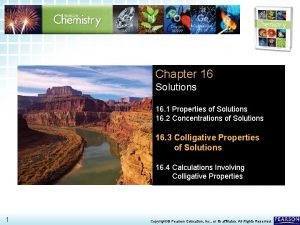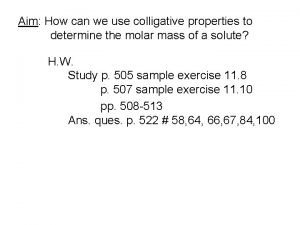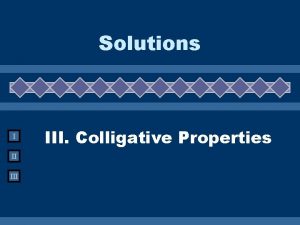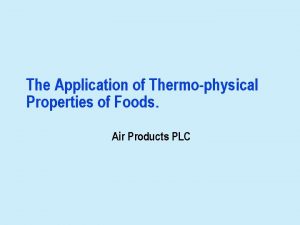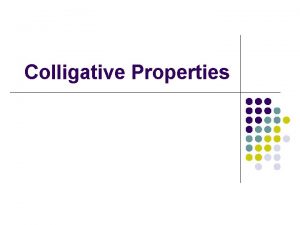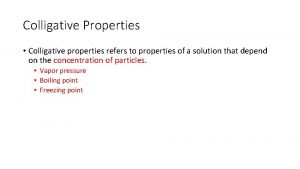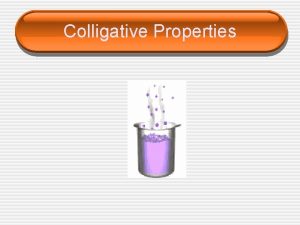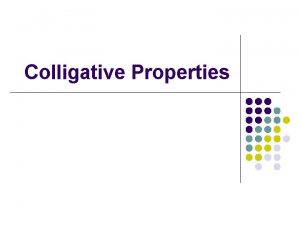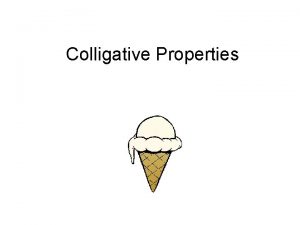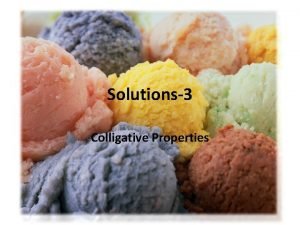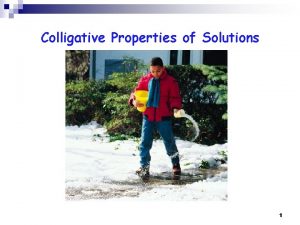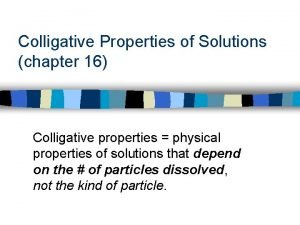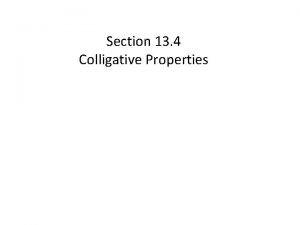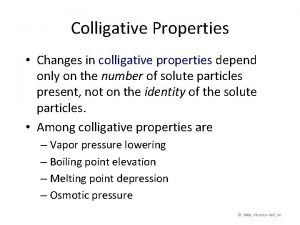Colligative Properties Colligative Properties n n properties that





















- Slides: 21

Colligative Properties

Colligative Properties n n ~properties that depend only on the solute’s concentration rather than what the solute is Simply adding a solute to a solvent will always have certain effects on the resulting solution.

Boiling point elevation/freezing point depression n All solutions will freeze at a lower temperature and boil at a higher temperature. Boiling point elevation and freezing point depression are colligative properties. That is to say it doesn’t matter what the solute dissolved in a solution, it will always boil at a higher temperature and freeze at a lower temperature.

Where it is used n n n Road salt goes into solution with snow, ice and water on the roads and lowers the freezing point. Since it a colligative property, it doesn’t matter what the solute is. Just whatever is available in that area. Water below the freezing point will not freeze and runs off the road, making it easier for a snow plow to clear the road.

Boiling Water n n n Students often assume that all boiling water is exactly at 100. 0 o C. That is normally not the case because of two factors; the air pressure, and anything dissolved in the water. Anything dissolved in the water will always raise the boiling point.

Calculations for boiling point elevation or freezing point depression n n n n T = change in temperature Boiling point elevation = BPnormal + T Where T = Kb (m)i Freezing Point Depression = FPnormal - T Where T = Kf (m)i Kb is the ebulliscopic constant Kf is the cyroscopic constant m is concentration of the solution in molality i is the Van’t Hoff factor

n n n n Van’t Hoff Factor (i) Colligative properties means it doesn’t matter what the solute is. Some things when dissolved dissociate (ionic compounds), which, if you don’t care what the solute is technically would increase the molality. Na. Cl (s) →Na+ (aq) + Cl- (aq) Sodium chloride dissociates into 2 things So it’s Van’t Hoff factor is 2 C 6 H 12 O 6(s) → C 6 H 12 O 6 (aq) Glucose is a covalent compound that doesn’t dissociate, so it’s Van’t Hoff factor is 1

Freezing Point Depression and Boiling Point Elevation Solvent Formula Melting Point (°C) Boiling Point (°C) Kf(°C/m) Kb(°C/m) Water H 2 O 0. 000 100. 000 1. 858 0. 512 Acetic acid HC 2 H 3 O 2 16. 60 118. 5 3. 90 3. 08 Benzene C 6 H 6 5. 455 80. 2 5. 12 2. 53 Chloroform CH 2 O -63. 5 61. 3 4. 68 3. 63 Carbon disulfide CS 2 -112 46. 3 3. 8 2. 34 Cyclohexane C 6 H 12 6. 55 80. 74 20. 0 2. 79 Ethanol C 2 H 5 OH -114. 6 78. 3 1. 99 1. 07

Problems n n We will only do a few problems with water solutions. I will give you the Kf or Kb on the test. You are expected to know the normal boiling and melting point of water.

Freezing point problem n n n Determine the freezing point of a 2. 1 m solution of water with calcium chloride (Ca. Cl 2) dissolved in it. Kf = 1. 858 °C/m (Van’t Hoff) Ca. Cl 2 →Ca 2+ + 2 Cl- = 3 T = Kf (m)i T = 1. 858 (2. 1) 3= 12 FPwater = 0. 00 – 12 = -12 o C

Boiling point problem n n n Determine the boiling point of a 1. 7 m solution of water with potassium nitrate (KNO 3) dissolved in it. Kb =. 512 °C/m (Van’t Hoff) KNO 3 →K+ + NO 3 - = 2 T = Kb (m) i T =. 512 (1. 7) 2= 1. 7 BPwater = 100. 00 + 1. 7 = 101. 7 o C

Freezing point problem n n n Determine the freezing point of a 3. 1 m solution of water with scandium bromide (Sc. Br 3) dissolved in it. Kf = 1. 858 °C/m (Van’t Hoff) Sc. Br 3 →Sc 3+ + 3 Br- = 4 T = Kf (m) i T = 1. 858 (3. 1) 4= 23 FPwater = 0. 00 – 23 = -23 o C

Boiling point problem n n n Determine the boiling point of a 2. 7 m solution of water with potassium sulfate (K 2 SO 4) dissolved in it. Kb =. 512 °C/m (Van’t Hoff) KNO 3 → 2 K+ + SO 42 - = 3 T = Kb (m) i T =. 512 (2. 7) 3= 4. 1 BPwater = 100. 00 + 4. 1 = 104. 1 o C

Vapor Pressure n n n Vapor pressure lowering is a colligative property. Vapor pressure, the amount of a liquid that will evaporate above a liquid, will be lower if anything is dissolved in it. If you have a mixture of two volatile liquids the one with a higher normal vapor pressure will evaporate at a higher rate.

Fractional distillation n n Fractional distillation makes use of vapor pressure lowering. Fractional distillation is used to separate petroleum or crude oil. Petroleum is a mixture of volatile liquids. The vapors above will be much more pure than the solution because the most volatile will lower the amount of other substances that can evaporate

Fractional Distillation

Chromatography n n Separating a solution by capillary action ~the attraction of a liquid to the surface of a solid, why water “climbs up things” For a simple chromatography place ink on chromatography paper and place the paper in a solvent with the ink above the water line. The solvent will “climb up” and separate the ink

Chromatography n n n In chromatography, a mobile phase carries something through a stationary phase. If different constituents have move at different speeds the material will be separated In simple paper chromatography the water is the mobile phase, the paper is the stationary phase.


Other types of chromatography n n Gas chromatography TLC, thin layer chromatography Column Chromatography HPLC, high performance liquid chromatography

Homework n Determine the boiling point of a 1. 5 m solution Al(Cl. O 3)3. n Determine the freezing point of a 2. 9 m solution of Ca(Mn. O 4)2. Kf = 1. 858 °C/m Kb =. 512 °C/m n n
 Tôn thất thuyết là ai
Tôn thất thuyết là ai Phân độ lown ngoại tâm thu
Phân độ lown ngoại tâm thu Walmart thất bại ở nhật
Walmart thất bại ở nhật Gây tê cơ vuông thắt lưng
Gây tê cơ vuông thắt lưng Block xoang nhĩ là gì
Block xoang nhĩ là gì Tìm vết của mặt phẳng
Tìm vết của mặt phẳng Sau thất bại ở hồ điển triệt
Sau thất bại ở hồ điển triệt Thể thơ truyền thống
Thể thơ truyền thống Hãy nói thật ít để làm được nhiều
Hãy nói thật ít để làm được nhiều Thơ thất ngôn tứ tuyệt đường luật
Thơ thất ngôn tứ tuyệt đường luật Colligative properties of milk
Colligative properties of milk Solutions chemistry regents questions
Solutions chemistry regents questions Ions in aqueous solutions and colligative properties
Ions in aqueous solutions and colligative properties Pure solvent
Pure solvent Is molarity a colligative property
Is molarity a colligative property Pure solvent
Pure solvent Non colligative properties examples
Non colligative properties examples Application of colligative properties in pharmacy
Application of colligative properties in pharmacy Calculating molar mass using colligative properties
Calculating molar mass using colligative properties 4 colligative properties
4 colligative properties Colligative properties definition
Colligative properties definition Applications of colligative properties in foods
Applications of colligative properties in foods










